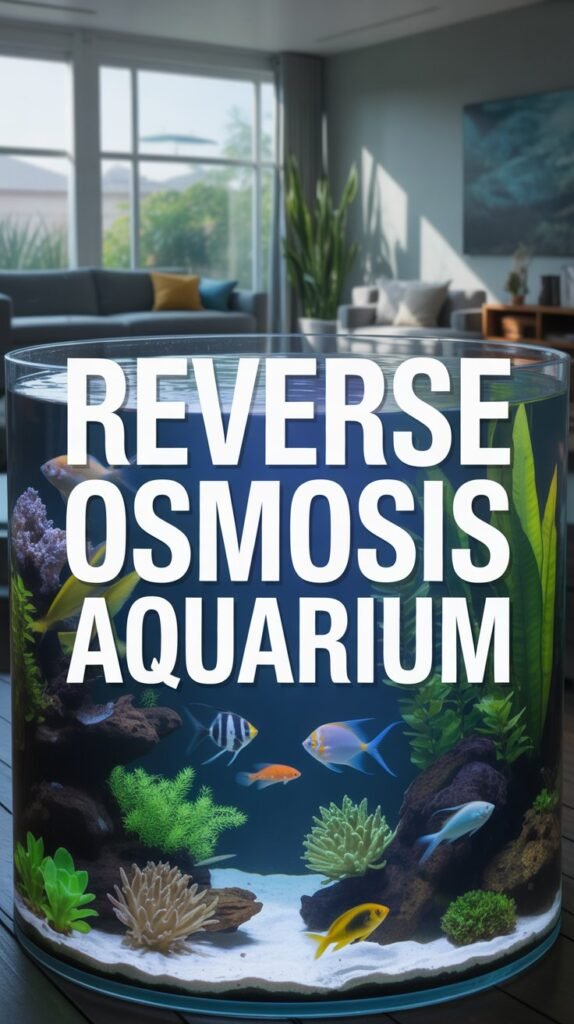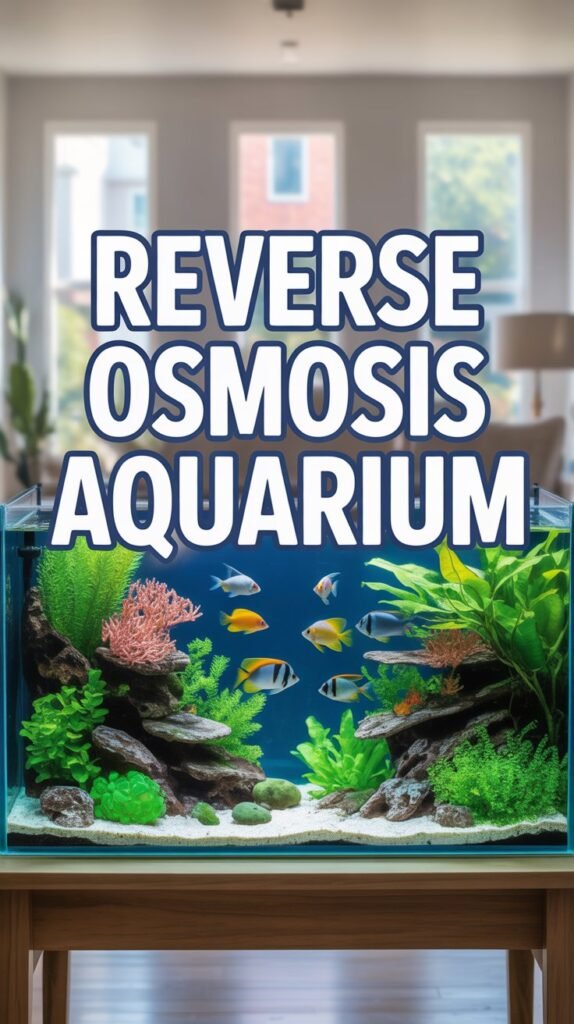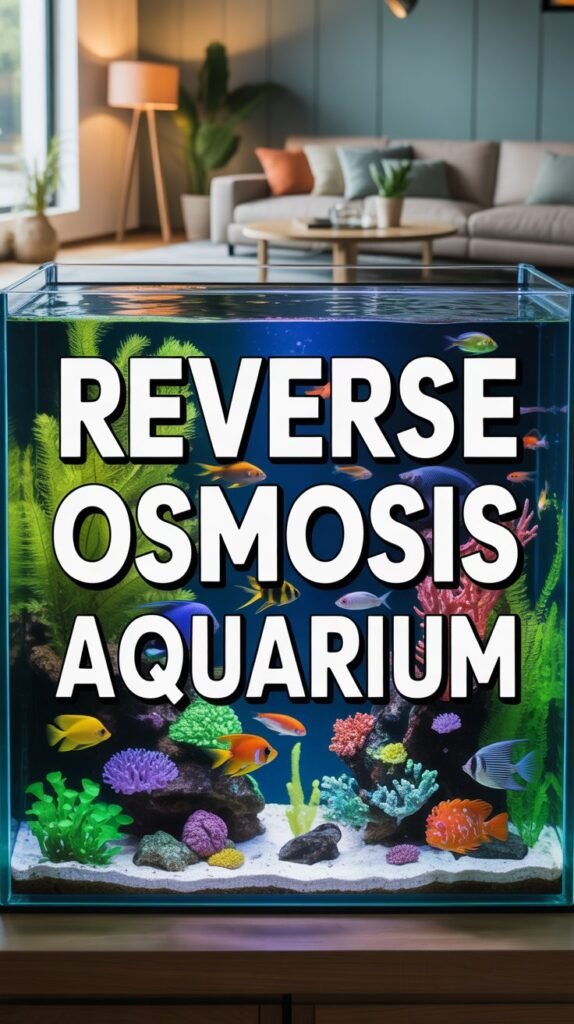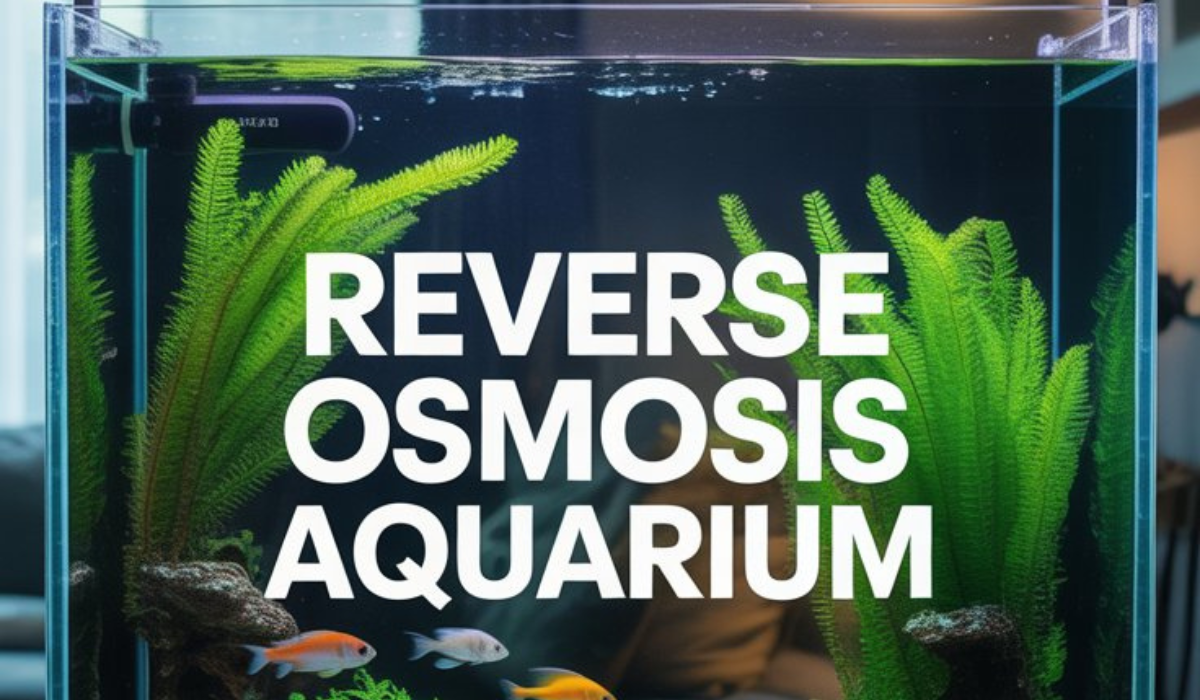Water quality is the foundation of every successful aquarium. Whether you keep delicate tropical fish, vibrant corals, or hardy freshwater species, maintaining the right water chemistry is essential for their health and longevity. One of the most effective ways to achieve this is through reverse osmosis (RO) water.
A reverse osmosis aquarium system provides ultra-pure water by removing impurities, chemicals, and dissolved minerals that could otherwise harm aquatic life. It gives aquarists full control over water parameters, allowing them to recreate specific natural environments — from soft, acidic Amazon biotopes to pristine reef ecosystems.
In this comprehensive guide, we’ll explore everything you need to know about using reverse osmosis in aquariums — how it works, why it’s beneficial, how to set it up, and how to maintain it for long-term success.
What Is Reverse Osmosis?
Reverse osmosis (RO) is a water purification process that removes contaminants using a semi-permeable membrane. Water is forced through the membrane under pressure, leaving behind impurities like chlorine, nitrates, heavy metals, and dissolved solids.
The result is pure, clean water, free from harmful substances that can cause fluctuations in pH, hardness, or other critical parameters in your aquarium.
How Reverse Osmosis Works

To understand how it benefits aquariums, let’s look at the step-by-step process:
- Pre-Filtration: Tap water passes through sediment and carbon filters that remove large particles, chlorine, and chloramines.
- RO Membrane: Water is pushed through a semi-permeable membrane that filters out up to 99% of dissolved solids and contaminants.
- Post-Filtration (optional): Some systems include additional polishing filters for enhanced purity.
- Storage or Output: The purified water is collected in a storage tank or directed straight to the aquarium system.
Why Use Reverse Osmosis in Aquariums?
Many aquarists wonder if RO water is truly necessary. The answer depends on the type of aquarium and the quality of your tap water. In most cases, RO water offers several key advantages that make it worth the investment.
1. Purity and Control
RO systems remove nearly all impurities, giving you a blank canvas to build the perfect water chemistry for your specific fish or plants. You can remineralize the water as needed.
2. Consistent Water Parameters
Unlike tap water, which varies depending on location and season, RO water has consistent quality. This stability helps prevent sudden parameter swings that stress fish.
3. Ideal for Sensitive Species
Species like discus, shrimp, and reef corals are highly sensitive to minerals and chemicals found in tap water. RO water provides the clean environment they need to thrive.
4. Prevents Algae Growth
High nitrate and phosphate levels often fuel algae blooms. Since RO systems remove these nutrients, they help maintain clearer, algae-free water.
5. Extends Equipment Life
By reducing mineral buildup, RO water helps prevent scaling in filters, heaters, and pumps, extending their lifespan.
Components of a Reverse Osmosis System
A reverse osmosis unit consists of multiple stages, each playing a crucial role in purifying water. Understanding each part helps you choose and maintain your system properly.
1. Sediment Filter
The first line of defense — it removes sand, silt, rust, and other large particles that could clog the membrane.
2. Carbon Block Filter
Removes chlorine, chloramine, and volatile organic compounds (VOCs) that can damage the RO membrane and harm aquatic life.
3. RO Membrane
The heart of the system — it eliminates up to 99% of dissolved salts, heavy metals, nitrates, and other contaminants.
4. Deionization (DI) Filter (Optional)
A DI filter uses ion-exchange resins to remove any remaining charged ions, achieving nearly 100% pure water. This step is especially important for reef tanks.
5. Flow Restrictor
Regulates water pressure across the membrane, ensuring optimal filtration efficiency.
6. Storage Tank
Holds purified water for future use, ensuring a steady supply when needed.
Reverse Osmosis vs. Tap Water in Aquariums

Let’s compare the two to understand why RO water often comes out on top:
| Parameter | Tap Water | Reverse Osmosis Water |
|---|---|---|
| Chlorine/Chloramine | Often present | Completely removed |
| Heavy Metals | May be present (lead, copper) | Removed |
| Dissolved Solids (TDS) | High | Very low (<10 ppm) |
| Hardness | Variable | Adjustable through remineralization |
| pH | Unstable | Neutral, customizable |
| Suitability for Sensitive Species | Poor | Excellent |
Tap water often contains chemicals and minerals that can harm delicate fish or interfere with plant growth. RO water, on the other hand, gives you the ability to customize your water parameters precisely.
Setting Up a Reverse Osmosis Aquarium System
Installing an RO system for your aquarium isn’t complicated, but it does require careful setup. Here’s a step-by-step guide.
Step 1: Choose the Right RO Unit
Select a unit based on your aquarium size and water needs. A 50 to 100 gallons-per-day (GPD) system suits most hobbyists, while larger tanks or reef systems may require higher capacity.
Step 2: Install Pre-Filters
Attach sediment and carbon filters before the RO membrane to protect it from clogging and extend its lifespan.
Step 3: Connect the RO Membrane
Insert the membrane into the housing, ensuring it fits tightly to prevent leaks.
Step 4: Set Up Water Lines
Connect the input (tap water), output (RO water), and waste (drain) lines as per manufacturer instructions.
Step 5: Flush the System
Run the system for a few hours initially to flush out any carbon dust or preservatives before using the water.
Step 6: Store or Direct Water
You can collect RO water in a container for later use or connect it directly to an auto top-off system for automatic aquarium refills.
Remineralizing Reverse Osmosis Water
While RO water is pure, it’s too pure for direct use. It lacks essential minerals like calcium, magnesium, and potassium that fish, invertebrates, and plants require. Therefore, remineralization is a crucial step.
Methods of Remineralization:
1. Using Commercial Remineralizing Products
Available as powders or liquids, these supplements add the correct balance of minerals. Popular formulations are designed for:
- Freshwater aquariums
- Shrimp tanks
- Planted tanks
- Reef aquariums
2. DIY Approach
You can manually add measured amounts of calcium sulfate, magnesium sulfate (Epsom salt), and potassium bicarbonate to achieve desired hardness levels.
3. Mixing RO Water with Tap Water
A simple and cost-effective option: blend RO water with a small portion of tap water (e.g., 80% RO + 20% tap) to restore some minerals naturally.
Target Parameters After Remineralization:
- General Hardness (GH): 4–8 dGH
- Carbonate Hardness (KH): 3–6 dKH
- pH: 6.5–7.5
Always test your water with reliable aquarium test kits to fine-tune the balance.
Reverse Osmosis for Freshwater Aquariums
In freshwater aquariums, RO water allows precise control of pH and hardness, especially for species from soft-water environments.
Ideal for:
- Discus
- Rams
- Tetras
- Shrimp
- Apistogramma
These species thrive in soft, slightly acidic water — conditions easily achieved with RO water.
Benefits for Planted Tanks
RO water prevents unwanted algae growth caused by high phosphate levels in tap water and helps ensure better nutrient absorption by aquatic plants. It’s particularly beneficial when combined with liquid fertilizers and CO₂ systems.
Reverse Osmosis for Saltwater and Reef Aquariums

For reef tanks, reverse osmosis is not just a luxury — it’s a necessity. Corals, anemones, and invertebrates are highly sensitive to even trace levels of contaminants.
Advantages:
- Eliminates Silicates and Phosphates: Prevents diatom blooms and algae outbreaks.
- Ensures Accurate Salinity: Since RO water has virtually no dissolved solids, your salt mix will produce precise salinity levels.
- Protects Corals and Invertebrates: Free from heavy metals and chemicals that harm delicate reef life.
- Reduces Maintenance: Clearer water and fewer algae mean less cleaning.
Ideal RO/DI Systems for Reef Tanks
A 4 or 5-stage RO/DI system is recommended, including:
- Sediment filter
- Carbon filter
- RO membrane
- Deionization (DI) resin
This setup delivers water with zero total dissolved solids (0 TDS) — perfect for coral growth.
Maintenance of RO Systems
Regular maintenance ensures your RO system operates efficiently and produces high-quality water.
1. Replace Filters on Schedule
- Sediment Filter: Every 6 months
- Carbon Filter: Every 6–12 months
- RO Membrane: Every 2–3 years (depending on water quality)
- DI Resin: When TDS levels rise above 10 ppm
2. Monitor Water Pressure
Low pressure reduces efficiency. Maintain 50–80 psi for optimal performance.
3. Flush the Membrane
Many systems have a flush valve that helps extend membrane life by removing buildup.
4. Check for Leaks
Inspect tubing connections regularly and replace worn-out O-rings or seals.
5. Test Output Water
Use a TDS meter to monitor water purity. Readings under 10 ppm indicate the system is functioning properly.
Common Problems and Solutions
Problem 1: Low Water Output
Cause: Clogged filters or low water pressure.
Solution: Replace filters or use a booster pump.
Problem 2: High TDS in Output
Cause: Worn-out membrane or DI resin.
Solution: Replace the affected components.
Problem 3: Leaking Fittings
Cause: Loose connections or damaged O-rings.
Solution: Tighten connections and replace faulty parts.
Problem 4: Slow Flow Rate
Cause: Cold water or low inlet pressure.
Solution: Use water at room temperature and maintain adequate pressure.
Problem 5: Taste or Odor in Water
Cause: Expired carbon filter.
Solution: Replace the carbon filter immediately.
Advantages and Disadvantages of RO Water in Aquariums
Advantages
- Provides ultra-pure water for sensitive species
- Prevents algae and chemical buildup
- Enables precise control over parameters
- Promotes healthy fish and coral growth
- Extends lifespan of aquarium equipment
Disadvantages
- Removes all minerals — requires remineralization
- Produces wastewater (typically 3:1 ratio)
- Initial setup cost can be high
- Requires periodic maintenance
Despite these drawbacks, the benefits far outweigh the cons for most dedicated aquarists.
Tips for Using Reverse Osmosis Water Effectively
- Always Remineralize Before Use: RO water alone lacks essential minerals.
- Store in Clean Containers: Prevent contamination by using food-grade barrels.
- Monitor TDS Levels Regularly: Ensures consistent purity.
- Use a Booster Pump if Needed: Improves efficiency in low-pressure areas.
- Flush the System Periodically: Extends membrane lifespan.
- Label Stored Water: Avoid confusion between RO water and untreated tap water.
- Combine with Auto Top-Off Systems: Perfect for maintaining stable water levels in reef tanks.
Environmental Considerations
RO systems do produce wastewater during filtration, but this water isn’t entirely wasted. It can be repurposed for:
- Watering plants or gardens
- Cleaning outdoor areas
- Washing vehicles
Being mindful of water usage helps offset environmental impact while still enjoying the benefits of high-quality aquarium water.
Conclusion
Using reverse osmosis water for aquariums is one of the smartest decisions an aquarist can make. It provides unmatched purity, stability, and control over water chemistry — essential for the health of fish, plants, and corals alike.
While it requires some setup and maintenance, the long-term benefits far outweigh the effort. With RO water, you eliminate the uncertainties of tap water, prevent algae problems, and create an environment that closely mimics natural habitats.
Whether you keep a lush planted freshwater tank or a thriving coral reef, a reverse osmosis aquarium system ensures your aquatic ecosystem remains balanced, healthy, and beautiful for years to come.
Frequently Asked Questions (FAQs)
1. What is the purpose of reverse osmosis in aquariums?
Reverse osmosis purifies tap water by removing impurities, ensuring the water is safe and customizable for aquarium use.
2. Can I use RO water directly in my aquarium?
No, RO water must be remineralized to restore essential minerals needed by fish and plants.
3. Is RO water good for freshwater aquariums?
Yes, it’s ideal for soft-water species and planted tanks, allowing precise control over pH and hardness.
4. How often should I change RO filters?
Replace sediment and carbon filters every 6–12 months, and the membrane every 2–3 years, depending on usage.
5. What does “TDS” mean in aquarium water?
TDS stands for Total Dissolved Solids, which measures the amount of dissolved minerals in water. RO water should have low TDS (<10 ppm).
6. Can I mix RO water with tap water?
Yes, blending both can restore minerals naturally and balance hardness levels.
7. Is RO water suitable for reef aquariums?
Absolutely. It prevents harmful substances from entering the tank and ensures stable salinity levels for corals.
8. Does reverse osmosis waste a lot of water?
RO systems produce some wastewater, typically 3 gallons for every 1 gallon of purified water, but this can be reused for non-aquarium purposes.
9. Do I need a DI filter with my RO system?
A DI filter is optional but highly recommended for reef aquariums where 0 TDS water is essential.
10. How can I tell if my RO system is working properly?
Use a TDS meter to check water purity. If readings rise above 10 ppm, it’s time to replace filters or resin.

